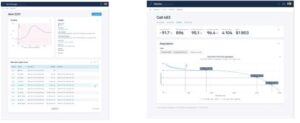By creating a virtual replica of a physical battery or a battery energy storage system (BESS), digital twins enable real-time monitoring, predictive maintenance, and optimization of battery performance. There are many examples of the use of digital twins in the industrial space. For instance, Siemens’ Virtual Power Plant (VPP) uses digital twins to optimize the performance and management of distributed energy resources, ensuring efficient energy distribution and storage. In Germany, a VPP project that aggregates the capacity of nine hydroelectric plants, has a total VPP capacity of 8.6 MW. 1 Similarly, the Fraunhofer Institute for Manufacturing Engineering and Automation has developed digital twins for battery cells to improve performance estimation and behavioral predictions2. In this issue, we’ll explore the practical applications of digital twins in battery analytics, highlighting their potential to revolutionize battery management systems.
As our readers already know, a digital twin is a virtual representation of a physical object or system, created to simulate its real-world counterpart in real-time. In the context of battery analytics, a digital twin mirrors the state and behavior of an actual battery cell by continuously collecting and analyzing data from embedded sensors. This can include voltage, current, and temperature sensors, as well as impedance measurements and strain gauges.
Real-Time Monitoring and Diagnostics
By continuously collecting data from sensors embedded in the physical battery, the digital twin can mirror the battery’s state and behavior. This in turn allows for immediate detection of anomalies, such as unexpected temperature rises or voltage drops, enabling swift corrective actions to prevent potential failures.3
For instance, in electric vehicles (EVs), real-time monitoring systems can detect anomalies, which could indicate potential issues such as cell imbalance or thermal runaway. Digital twin solutions such as Peaxy Lifecycle Intelligence utilize advanced data-centric AI platforms to provide comprehensive real-time analytics on battery performance, helping to prevent sudden breakdowns and ensure 100% uptime. This continuous data collection and analysis enables immediate corrective actions, reducing the risk of battery failure and extending the overall lifespan of the battery.
As an example in the case of a battery management system, digital twins use real-time data from sensors to compute key metrics such as state of charge (SoC), state of health (SoH), state of power (SoP) and round trip efficiency (RTE). By leveraging a cloud-enhanced BMS, such solutions can offer intelligent fault diagnostics and performance optimization. The real-time diagnostics not only enhance the reliability of batteries in applications like grid energy storage and electric transportation but also contribute to more sustainable energy solutions by optimizing battery usage over time and reducing the rate of failure and thus waste.
Predictive Maintenance
Digital twins excel in predictive maintenance with advanced analytics and machine learning algorithms. By analyzing both historical and real-time data, digital twins can accurately predict when a battery is likely to fail, or degrade to end of life (EOL) or require augmentation. This predictive capability is crucial for timely maintenance and upgrades, as it allows for the identification of potential issues before they become critical. For example, in industrial applications, digital twins can monitor the performance of battery systems in real-time, identifying patterns and anomalies that indicate wear and tear. Such a proactive approach helps in scheduling maintenance activities at the most opportune times, thereby reducing unexpected downtime and ensuring continuous operation.
Augmenting a lithium-ion BESS site is essential to meet contractual commitments especially with power purchase agreements (PPA) but results in significant capital expense (CAPEX). Improving the accuracy of SOH degradation based on actual operating performance avoids missing PPA contractual commitments and committing to CAPEX either too early or late. A digital twin improves SOH forecasting by calculating a daily SOH independent of the BMS based on each batteries’ degradation and equivalent cycles. Machine learning ingests industry and OEM degradation forecasts and site specific cell performance. Machine learning will also adjust the degradation forecast based on actual stressful operations including high C-rates, calendar aging, temperature variations, cycles per day, etc. In addition, degradation forecasts can be created for new use cases leveraging the machine learning algorithms. Operational improvements can also be identified to extend the equivalent cycle life of the battery.
In the context of electric vehicles (EVs), digital twins play a pivotal role in optimizing battery health and performance. In addition to forecasting the state of health (SoH) and state of charge (SoC) of the battery, the system can suggest optimal charging cycles that maximize efficiency and longevity. Companies like Tesla use digital twin technology to monitor and manage their EV batteries, ensuring they operate at peak performance while extending their lifespan. This not only enhances the reliability of the vehicles but also contributes to a more sustainable and cost-effective energy solution. It’s estimated that based on 2023 sales, Tesla created and managed over 1.8 million digital twins. 2
Each Tesla vehicle has its own digital twin, a virtual replica that continuously receives data from the car’s sensors. This data includes performance metrics, sensor readings, and operational conditions, which are processed in real-time to monitor the vehicle’s health and performance. By analyzing the data collected from the vehicles, Tesla can predict potential issues before they become critical and refine and improve its Autopilot and Full Self-Driving (FSD) systems. By simulating various driving scenarios and conditions, digital twins help in training the AI algorithms that power these systems, making them safer and more reliable.
One of the main challenges in implementing digital twins such as in this example is the sheer volume of data generated by millions of vehicles. Managing and processing this data requires substantial network bandwidth, data storage, and computational power in the cloud. Another challenge is the ever increasing level of cyber threats. It’s critical to partner with a provider that not only can implement robust cybersecurity measures to protect the data from unauthorized access and potential breaches, but can demonstrate a track record of having done so. Our work with the Department of Defense and Energy spans fourteen cumulative years, and our customers benefit from the same military-grade security ciphers and data storage and information security techniques used by the most security-conscious organizations in the world.
Enhanced Safety
Safety is paramount in battery management, and digital twins play a crucial role in enhancing it by continuously monitoring the battery’s state. For example, in battery storage, digital twins can detect early signs of thermal runaway, short circuits, or other hazardous conditions by analyzing real-time data from temperature, voltage, and current sensors. This early detection allows for prompt intervention, such as adjusting the cooling system or isolating faulty cells, thereby mitigating risks and ensuring the safe operation of the battery.
In large-scale battery energy storage systems (BESS) used for grid storage, digital twins can track parameters such as temperature, voltage, current, and pressure across thousands of individual cells. This real-time monitoring allows for the early detection of anomalies like overheating, short circuits, or cell imbalances, which could lead to safety hazards. By identifying these issues early, digital twins enable prompt intervention, such as adjusting cooling systems or isolating faulty cells, thereby mitigating risks and ensuring the safe operation of the entire battery system. According to a study published in the journal Applied Energy, the implementation of digital twins in a 1 MWh grid battery system consisting of 18,900 cells demonstrated a significant reduction in cell-to-cell variations over a 10-year simulation period. This monitoring and control led to a decrease in battery failures and extended the overall lifespan of the battery system. 4
Improving Sales
Peaxy has extensive experience working with digital twins for the US Department of Defense and GE. For example, Peaxy created a virtual representation of a power plant for a major turbine OEM, which provided a range of benefits. In commercial applications, potential customers were amazed with the ability to physically walk through an augmented power plant, while sales benefited from proposal optimization (configuration, performance, life-cycle cost) and automation. A turnkey power plant could be generated within an hour. The digital twin also provided customer training and virtual service support. From a lifecycle optimization standpoint, the digital twin provided OPEX and performance visibility and optimization, degradation forecasting, and maintenance and obsolesce planning. Perhaps most importantly, our customers saw accelerated innovation with new products and services identified, along with validation simulations and reduced redesign.

Peaxy created a digital twin based on virtual reality, that allowed stakeholders to view and tour equipment in real-time to monitor performance and accelerate innovation by identifying new products and services with reduced redesign.
Peaxy’s digital twins are used on board US Navy submarines, where they provide emulation, simulation, monitoring, and condition based maintenance (CBM) for the critical systems on board ranging from engines to compressors and storage batteries.
Peaxy also deployed digital twins on the Ford class aircraft carrier, to provide real-time and emulated system-level monitoring for advanced on-board systems. Primary output from the digital twin, in addition to CBM, includes real-time and emulated system-level monitoring, 3D animated models that provide fault and diagnostic data, and an emulator control console with realistic ladder logic. In addition, an expert system provides an instantaneous pareto of available remedies with spares status and testing time requirements.

Digital twins for Peaxy customers provide technical analysis, emulation, simulation, monitoring, and CBM, enabling lifecycle maintenance for critical systems.
Lifecycle Management
Digital twins facilitate comprehensive lifecycle management of batteries. By tracking the battery’s performance and health over time, digital twins provide valuable insights into aging patterns and degradation mechanisms. This information is essential for developing strategies to extend battery life and improve recycling processes. For example, digital twins can help identify the optimal time to repurpose or recycle batteries, contributing to a more sustainable battery ecosystem. 5
In a battery energy storage system context, a digital twin can identify underperforming cells and provide advanced alerts and degradation forecasting. Threaded data input, pipelines and models, including test and build data, real-time computations and degradations, and a BMS emulator provide instant insights into anomalous temperatures, voltage and degradation, with secondary outputs in the form of alerting and forecasting.
Partial differential equations (PDEs) play a crucial role in the development and functionality of digital twins, especially in complex systems like battery analytics. PDEs are mathematical equations that describe the relationships between the various partial derivatives of a multivariable function. They are used to model the behavior of physical systems over time and space, capturing the dynamics of processes such as heat transfer, fluid flow, and structural deformation.
In the context of digital twins for battery systems, PDEs can be used to model the thermal behavior of batteries. For example, the heat equation, a type of PDE, can describe how heat is distributed and evolves within a battery over time. By solving this equation, the digital twin can predict temperature changes within the battery, helping to prevent overheating and thermal runaway. This predictive capability is essential for ensuring the safety and longevity of battery systems.
Another application of PDEs in digital twins is in modeling the electrochemical processes within batteries. The Nernst-Planck equation, which is a PDE, can be used to describe the diffusion and migration of ions within the battery’s electrolyte. By solving this equation, the digital twin can simulate the concentration profiles of different ions, providing insights into the battery’s state of charge and health and overall lifecycle stage. This information is crucial for optimizing battery performance and predicting maintenance needs.6
Conclusion
Digital twins are poised to revolutionize battery analytics by providing real-time monitoring, predictive maintenance, performance optimization, enhanced safety, and comprehensive lifecycle management. As the technology continues to evolve, its integration with IoT and AI will unlock even greater potential, driving advancements in battery technology and contributing to a more sustainable energy future. Embracing digital twins in battery management systems is not just a technological upgrade; it’s a strategic move towards smarter, safer, and more efficient energy solutions.
- Case Studies and Real-World Examples of Digital Twin Implementation | by Sahilbhutada | Medium; How Real are Virtual Power Plants? (power-grid.com)
- Batteries | Free Full-Text | Implementation of Battery Digital Twin: Approach, Functionalities and Benefits (mdpi.com); 2208.14197 (arxiv.org); Tesla’s Digital Twins | Mike Kalil
- Predictive Maintenance Using a Digital Twin – MATLAB & Simulink (mathworks.com)Machines | Free Full-Text | Building a Digital Twin Powered Intelligent Predictive Maintenance System for Industrial AC Machines (mdpi.com)
- S2542-4351(23)00135-6.pdf (cell.com)
- https://arxiv.org/pdf/2208.14197
- https://www.nature.com/articles/s42256-024-00844-4.pdf

